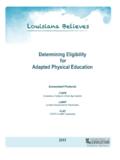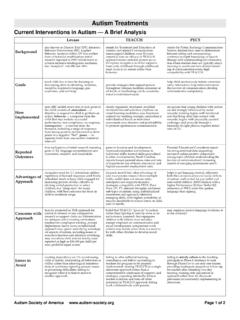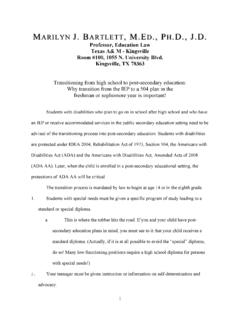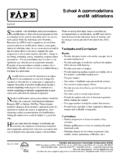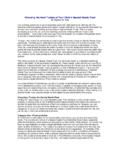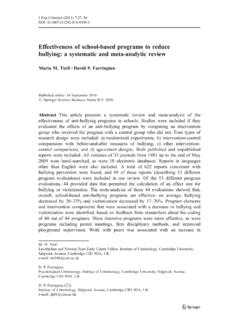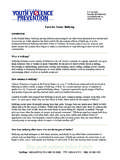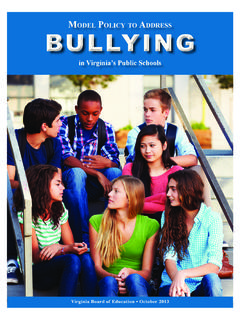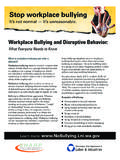Transcription of Best Practices in Bullying Prevention and …
1 best Practices in Bullying Prevention and InterventionBullying is aggressive behavior that is intentionaland that involves an imbalance of power orstrength. Often, it is repeated over time and cantake many forms. In many respects, research onbullying Prevention is still in its infancy. Althoughresearchers have documented success of somecomprehensive programs in reducing Bullying , westill have much to learn about which aspects ofthese programs are most important. However, a review of existing Bullying preventionprograms and feedback from educators in the fieldled us to suggest ten strategies that represent bestpractices in Bullying Prevention and Focus on the social environment of the school.
2 To reduce Bullying , it is important to change the climate of the school and the socialnorms with regard to Bullying . It must become uncool to bully, cool to help out students whoare bullied, and normative for staff and students to notice when a child is bullied or left out. Thisrequires the efforts of everyone in the schoolenvironment teachers, administrators, counselors,other non-teaching staff (such as bus drivers,nurses, school resource officers, custodians,cafeteria workers, and school librarians), parents, and Assess Bullying at your school. Intuitivelyadults are not always very good at estimating thenature and extent of Bullying at their we are quite surprised by the amount of Bullying that students experience, the types ofbullying that are most common, or the hot spots where Bullying happens.
3 As a result, it is often quiteuseful to assess Bullying by administering ananonymous questionnaire to students aboutbullying. What are the possible benefits ofconducting a survey of students? Findings can help motivate adults to take actionagainst Bullying ; Data can help administrators and other educatorstailor a Bullying Prevention strategy to theparticular needs of the school; and Data can serve as a baseline from whichadministrators and other educators can measuretheir progress in reducing Garner staff and parent support forbullying Prevention .
4 Bullying Prevention shouldnot be the sole responsibility of an administrator,counselor, teacher or any single individual at aschool. To be most effective, Bullying preventionefforts require buy-in from the majority of the staffand from Form a group to coordinate the school sbullying Prevention activities. Bullyingprevention efforts seem to work best if they arecoordinated by a representative group from theschool. This coordinating team (which mightinclude an administrator, a teacher from eachgrade, a member of the non-teaching staff, a schoolcounselor or other school-based mental healthprofessional, a school nurse, and a parent) shouldmeet regularly to digest data from the schoolsurvey described in Strategy 2; plan bullyingprevention rules, policies, and activities; motivatestaff, students, and parents; and ensure that theefforts continue over time.
5 A student advisorygroup also can be formed to focus on bullyingprevention and provide valuable suggestions andfeedback to and other materials are available online at: Train your staff in Bullying administrators, faculty, and staff at your schoolshould be trained in Bullying Prevention andintervention. In-service training can help staff tobetter understand the nature of Bullying and itseffects, how to respond if they observe Bullying ,and how to work with others at the school to helpprevent Bullying from occurring. Training shouldnot be available only for teaching staff.
6 Rather,administrators should make an effort to educate alladults in the school environment who interact withstudents (including counselors, media specialists,school resource officers, nurses, lunchroom andrecess aides, bus drivers, parent volunteers,custodians, and cafeteria workers).6. Establish and enforce school rules andpolicies related to Bullying . Although manyschool behavior codes implicitly forbid Bullying ,many codes do not use the term or make explicit our expectations for student behavior. It is importantto make clear that the school not only expectsstudents not to bully, but that it also expects them tobe good citizens, not passive bystanders, if they areaware of Bullying or students who appear troubled,possibly from Bullying .
7 Developing simple, clearrules about Bullying can help to ensure that studentsare aware of adults expectations that they refrainfrom Bullying and help students who are bullied. Forexample, one comprehensive program, the OlweusBullying Prevention Program (see resources sectionon the Web site) recommends that schools adoptfour straightforward rules about Bullying : We will not bully others. We will try to help students who are bullied. We will make it a point to include students who are easily left out. If we know someone is being bullied, we will tell an adult at school and an adult at rules and policies should be posted anddiscussed with students and parents.
8 Appropriatepositive and negative consequences also should be developed for following or not following theschool s Increase adult supervision in hot spotswhere Bullying occurs. Bullying tends to thrivein locations where adults are not present or are notvigilant. Once school personnel have identified hotspots for Bullying from the student questionnaires,look for creative ways to increase adults presencein these Intervene consistently and appropriatelyin Bullying situations. All staff should be able tointervene effectively on the spot to stop Bullying ( , in the 1 2 minutes that one frequently has todeal with Bullying ).
9 Designated staff should alsohold sensitive follow-up meetings with childrenwho are bullied and (separately) with children whobully. Staff should involve parents of affectedstudents whenever Focus some class time on bullyingprevention. It is important that bullyingprevention programs include a classroomcomponent. Teachers (with the support ofadministrators) should set aside 20 30 minuteseach week (or every other week) to discuss bullyingand peer relations with students. These meetingshelp teachers to keep their fingers on the pulse of students concerns, allow time for candiddiscussions about Bullying and the harm that it can cause, and provide tools for students to addressbullying problems.
10 Anti- Bullying themes andmessages also can be incorporated throughout theschool Continue these efforts over time. Thereshould be no end date for Bullying preventionactivities. Bullying Prevention should be woven intothe entire school environment.
